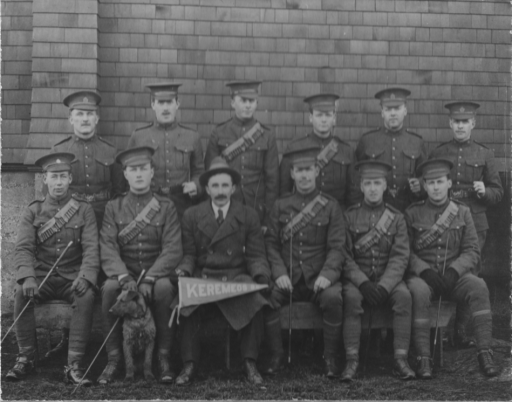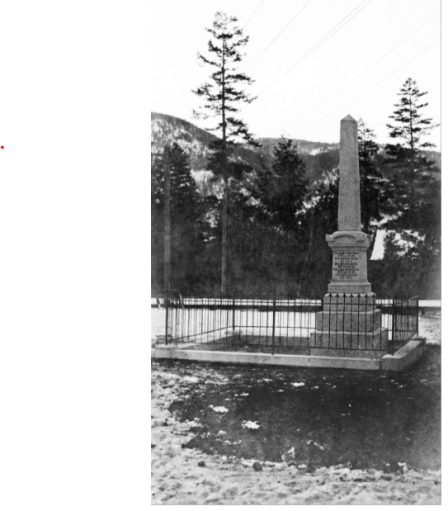Residents in the small Similkameen Valley village of Hedley, B.C., gathered around the cenotaph at the end of Main Street on Remembrance Day, as they have done for the past 101 years.
The column of granite, listing the names and ranks of fallen soldiers, has stood in the very same spot for more than 100 years, making it one of the earliest First World War memorials in Canada.
“Most communities were still tallying up the casualties, they were still raising money for it,” said local war historian Andy English.
Read more:
Impromptu Remembrance Day ceremony attracts crowd in Kelowna
“Hedley had all of that knowledge, the money, and they were able to do it.”
The cenotaph’s construction was started in August 1919 and it was unveiled on Dec. 14, 1919.

This photo shows the Keremeos recruits in 1914. Sid Edwards, the first Hedley Boy to be killed in action, is on the far right top row. On the far left top row is Bob McCurdy, who was badly wounded at the Battle of Festubet, the same action that saw Sid Edwards killed by shellfire. Sid Edwards has no known grave while Bob McCurdy died in 1919 in Hedley and is buried in Keremeos Cemetery.
Courtesy: Keremeos Museum
It was funded by the contributions paid into the Hedley Patriotic Fund.
The fund raised thousands of dollars throughout the war to provide the troops with home comforts in the form of parcels and to top up any wages lost by enlisting.
“This was a very wealthy town, we had the richest gold mine in North America,” English said.

“At the wars end, so many of them were dead and wounded, they paid out a big chunk of money to the survivors, but there was still $900 left, and they used that for this monument.”
Read more:
Released on Remembrance Day, Second World War movie shot entirely on location in B.C.
In total, there are 13 men from the First World War and four men from the Second World War on the Hedley cenotaph.
The fallen soldiers are fondly remembered as the “Hedley Boys.”
In total, 58 Hedley men joined the Canadian Expeditionary Force and of them, 11 were killed. One of them was Jack Lorenzetto.

The Hedley Cenotaph as it looked soon after unveiling circa 1920.
Courtesy: Copyright Hedley Museum
The 24-year-old was the last Hedley soldier to die in action in September 1918.
He had been at the front for only a month.
Lorenzetto was the eldest of 14 siblings and was on course to be a successful rancher until he was conscripted.
Read more:
‘I lost lots of friends’: For 100-year-old B.C. veteran, memories of WWII never fade
He is the only soldier in the Canadian army to list Hedley as his birthplace, four years before Hedley existed.
Lorenzetto was likely born in the Ashnola area, between Keremeos and Hedley, English said.
Daryl Brewer comes to the cenotaph every Remembrance Day to honour his great uncle.
“They were just kids, and many of them died as just kids,” Brewer said.

“I think it is really important that their names stay alive here so people can understand the contribution that was made from this little community right here.”
Men from Hedley fought in every major Canadian battle of the war from the 2nd Battle of Ypres in April 1915 to the Battle of Valenciennes in November 1918.
Two Hedley boys died on the slopes of Vimy Ridge.
The first Canadian to set foot on what is now the site of the National Memorial at Vimy Ridge, was Alec Jack, a Hedley man and future member of the cenotaph committee in 1919.
All this from a town of less than 400 people.
English has dedicated the past seven years to researching the stories of the men whose names are etched on the cenotaph.
You can list to his nine-part podcast series here.